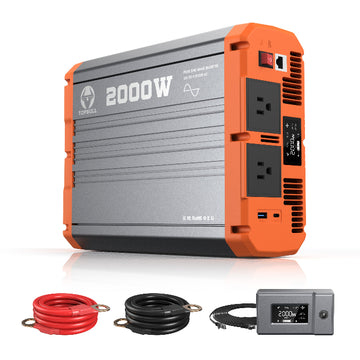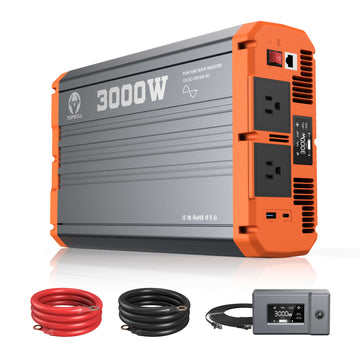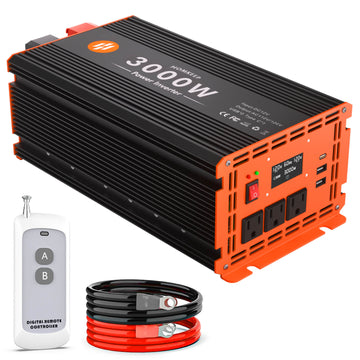With the popularity of electronic devices, people want to have easy access to various electrical appliances such as laptops, cell phone chargers, and mini-fridges in their cars as well. So, how to power these devices efficiently and safely in the car? The answer is exactly that - a car inverter! This small but powerful device can convert the direct current (DC) from the car battery to the alternating current (AC) we need in our daily life, which not only extends the function of the car, but also makes our traveling more convenient and flexible.
How a car inverter works
The core function of an inverter is to convert direct current to alternating current. This process can be divided into two basic types of current:
-
Direct Current (DC): the type of current supplied by automotive batteries and used primarily to start the engine and support automotive electronics.
- Alternating Current (AC): the type of current required by most household appliances and devices such as computers and televisions.
The workflow of an inverter mainly consists of receiving a DC power source and converting it to the AC power required by the user through internal circuits and components.
The working process of car inverter
The working process of a car inverter can be divided into the following steps:
-
Power input: the inverter receives DC power from the car battery.
-
Current conversion: The inverter converts the DC power to AC power by means of switching elements and transformers. This process usually involves a “switching frequency”, i.e. the current is rapidly switched within a specific frequency to produce AC power.
-
Power output: The converted AC power is output at the desired voltage and frequency and can be used in electrical equipment.
At the same time, it is vital that the inverter has a power rating such as 400W, 1000W, 2000W, etc. When using an inverter you need to make sure that its power is sufficient to support the energy consumption of the desired device.
Who needs a car inverter
Almost anyone who spends a lot of time on the road can benefit from a car inverter, especially in scenarios such as long-distance traveling, camping, business trips and long-distance trucking. Enthusiasts who frequently go on long trips or camping trips need it to power electronic devices to record moments and stay connected; business people can efficiently use office equipment in their vehicles; emergency responders rely on it to provide stable power for medical and communication equipment; and even regular car owners want to enjoy a more comfortable driving experience during their daily commute, such as using a car vacuum cleaner and an inflator pump.

Car inverters can run devices
Below is a list of some of the common devices that can be run through a car inverter:
| Equipment Type | Specific Devices |
| Small electronic devices | Cell phones, tablets, Bluetooth headsets, smart watches, e-readers, portable game consoles |
| Office and Entertainment Devices | Laptop computers, portable projectors, electronic dictionaries, drawing boards, portable printers |
| Living Appliances | Car refrigerator, electric kettle, small rice cooker, coffee maker, car vacuum cleaner, electric shaver, hair dryer |
| Medical and Health Equipment | Portable Oxygen Concentrator, Massager, Electronic Blood Pressure Monitor (some support AC), Portable Nebulizer |
| Photography and Video Equipment | Digital cameras, camcorders, drones (some support AC charging), stabilizers |
| Other Equipment | Car air purifiers, car humidifiers, small electric fans, LED light strips (for interior decoration) |
Tip: Different devices have different power and need to be equipped with inverters of the right power size, while also considering the carrying capacity of the car battery.
What are the types of car inverters
Car inverters can be categorized into various types based on output waveform and power level:
According to the output waveform:
-
Square wave inverter: the output waveform is close to square wave, which is suitable for electrical appliances that do not require high waveform, such as chargers and power tools.
-
Modified sine wave inverter: Improved on the basis of square wave, the output waveform is smoother, suitable for most electronic devices.
- Pure sine wave inverter: the output waveform is close to the waveform of household electricity, suitable for all types of equipment, relatively high price.
According to the power size:
-
Small inverter: the power is usually below 100W, suitable for small power appliances such as cell phones and tablet PCs.
-
Medium inverter: power between 100W and 1000W, suitable for laptop, small refrigerator and other medium power appliances.
- Large inverter: power above 1000W, suitable for high-power appliances, such as induction cooker, microwave oven, etc. (but need to pay attention to the carrying capacity of car battery).
Factors to consider when buying a car inverter
Power Requirements
When shopping for a vehicle inverter, you first need to understand the devices you will be connecting and their total power requirements. Calculate the total power of all the devices and select an inverter with a power rating higher than the total demand to ensure safe use and prolong the life of your equipment.
Inverter Types
There are three main types of inverters: square wave, modified sine wave and pure sine wave. Square wave inverters are suitable for simple appliances, modified sine wave inverters are suitable for most equipment, and sine wave inverters are suitable for high-end equipment. It is vital that you choose the right type for your equipment's needs.
Input Voltage Range
Ensure that the input voltage range of the inverter matches that of the car battery (usually 12V or 24V) to avoid malfunctions due to voltage mismatch.
Output socket type
Check the output socket type of the inverter to ensure it matches the needs of your device. Most inverters come with AC outlets and USB ports for easy connection of different devices.
Efficiency and Heat Dissipation
A high-efficiency inverter reduces energy loss, while a good heat dissipation design prevents overheating and ensures long-term stable operation of the device.
Safety Protection Functions
Choose an inverter with overload, short-circuit, over-temperature and low-voltage protection to ensure that the equipment and the inverter itself can be effectively protected in the event of abnormalities during use.
Portability
Consider the size and weight of the inverter if it needs to be moved frequently. Choose a lightweight and compact model that is easy to carry and use.
Large car inverter recommendation
Large car inverters are typically used when a high power output is required, such as powering devices such as refrigerators, microwaves, and power tools during long trips or camping trips. They are also suitable for emergency power supply and can support the normal operation of household appliances in the event of a power outage. In addition, business uses such as mobile food trucks and situations where multiple devices need to be charged at the same time require large inverters to ensure stable operation and efficient power supply. In short, large vehicle inverters are considered for any scenario that requires high power and stable power supply.
Topbull 2000W car inverters are ideal for long distance traveling, outdoor activities and multi-device use due to their high power output, pure sine wave power, safety protection and user-friendly design.
Topbull 2000W power inverter for car

Product features:
-
High power output: provides 2000W continuous power and 4000W peak power, suitable for high power devices such as refrigerators and microwave ovens.
-
Pure sine wave output: Ensures power quality, suitable for sensitive devices such as stereos and laptops, contributing to safe and stable operation.
-
Multiple interfaces: Multiple AC outlets and USB ports, capable of powering multiple devices at the same time, convenient for users.
-
Safety protection features: Built-in overload, short-circuit and overheating protection ensures safe use.
-
Compact design: easy to install and carry, suitable for a wide range of vehicles.
-
High efficiency: high efficiency operation, reduce energy loss, prolong use time.
- Good heat dissipation: Effective heat dissipation system prevents overheating and enhances reliability.
How to connect a car inverter
In order to be able to use all kinds of electrical devices in the car, the inverter must be properly connected to the car battery. Below are several common ways to connect the inverter and their characteristics:
1. Connection via cigarette lighter or 12V accessory socket
Connection method:
This is the easiest way to connect the inverter, just plug the inverter into the cigarette lighter or 12V accessory socket of the car.
Features and Limitations:
-
Simplicity: no additional tools or specialized knowledge required, plug and play.
-
Current Limit: Because cigarette lighter or accessory circuits are often designed for low-power devices, inverters are often limited to 5 or 10 amps when connected this way. This means that the power of electrical devices that the inverter can support is relatively small.
- Equipment limitation: Due to the current limitation, the type of electrical equipment that can be connected to the inverter is correspondingly limited and cannot support high power equipment.
2、Connected through the fuse panel
Connection method:
There are empty slots reserved on the fuse panel of some automobiles, through which the inverter can be connected to the automobile circuit.
Features and Advantages:
-
Dedicated circuit: When the inverter is connected through the fuse panel, it can have a dedicated circuit to avoid interference or overload caused by sharing the circuit with other high-power devices.
-
Safety: The fuse on the fuse panel can cut off the circuit in time when the current is too high, protecting the inverter and car battery from damage.
- Flexibility: According to the design of the fuse panel, you can flexibly choose fuses with different rated currents to adapt to inverters with different power.
3、Directly connected to car battery
Connection method:
In heavy duty applications or where high power support is required, the inverter can be connected directly to the car battery. This usually requires the use of specialized cables and terminals, and ensuring a strong and reliable connection.
Features and Precautions:
-
High power support: Connecting directly to the battery ensures that the inverter receives sufficient power support to meet the needs of high-power electrical equipment.
-
Safety is critical: Since connecting directly to the battery may pose a higher risk (e.g. short-circuit, overload, etc.), it is important to protect the circuit with a fuse or circuit breaker of appropriate current rating. In addition, the connection process should ensure that the positive and negative terminals of the battery are properly connected to avoid short circuits.
- Professional operation: Direct connection to the battery requires certain specialized knowledge and operating skills, and it is recommended that it be operated or instructed by a professional.
FAQs about car inverter
1. Why can't my cigarette lighter supply power to the inverter?
The cigarette lighter power circuit may already have other devices connected to it, resulting in insufficient current. Additionally, many cigarette lighter circuits are typically rated with a current limit of 5 or 10 amps, which is insufficient to support a high power inverter. If the inverter power exceeds the cigarette lighter's limit, the cigarette lighter may blow a fuse or lose power.
2. How much power can a vehicle inverter support?
The power of an inverter is usually determined by its rating, common inverters are 300W, 600W, 1000W, 2000W or even higher. Exactly how powerful a device can be supported depends on the type of Modified Wave Inverter (e.g. Modified Wave or Pure Sine Wave) and the power rating. When selecting a device, make sure its power is less than the rated power of the inverter to avoid overloading.
3. What do I need to be aware of when using high power devices on the inverter?
When using high power devices, make sure that the power of the inverter is sufficient to meet the demand of the device and check that the starting current of the device is not higher than the rated power of the inverter. In addition, pay attention to the temperature of the inverter during use to avoid overheating, and try to avoid running the high power device for a long time when the car is off to avoid draining the car battery.
4. Will the car battery be affected when using an inverter?
Using the inverter will drain the car battery. If the inverter is used with high power devices while the car is off, it may cause the battery to be over-discharged, thus affecting the starting performance. To protect the battery, it is recommended to consider connecting the inverter directly to the auxiliary battery when using it for extended periods of time.
5. Is it possible to connect more than one device at the same time?
Yes, but make sure that the total power consumption of all connected devices does not exceed the power rating of the inverter. For example, if the inverter is 2000W, the total power of the devices connected at the same time should be lower than that value. In addition, make sure that the number of sockets in the inverter is sufficient, taking into account that the devices used may generate a higher starting current at the beginning.
6. Will the inverter damage my electronic equipment?
If the right type of inverter is used (e.g. a pure sine wave inverter), it will not normally damage electronic equipment. However, if a Modified Wave Inverter is used, certain sensitive equipment (e.g. high-end audio, precision instruments, etc.) may be affected. Check the power requirements of the equipment and the type of inverter output before connecting.
7. What types of batteries does the inverter work with?
Most car inverters are suitable for 12V or 24V lead-acid and lithium batteries. Common lead-acid batteries are traditional starting batteries and deep cycle batteries. When selecting a battery, make sure its voltage rating matches the inverter, and consider the battery's capacity and discharge capability to support the inverter's needs.











![How to Install A Power Inverter in A Truck [Best Guide]](http://www.topbullshop.com/cdn/shop/articles/How-to-Install-A-Power-Inverter-in-A-Truck.jpg?v=1743407247&width=360)

